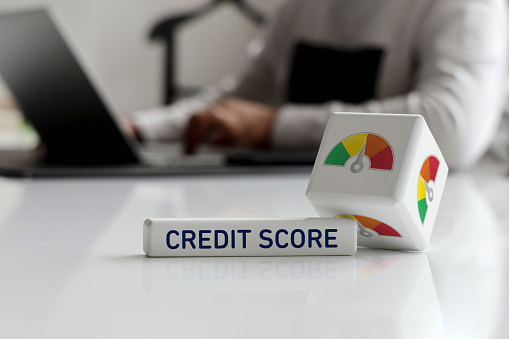What is a credit score?
A credit score is a numerical value that represents an individual’s creditworthiness. It is used by financial institutions and lenders to determine a borrower’s likelihood of repaying a loan. The most widely used credit score model in the United States is the FICO score, which ranges from 300 to 850, with higher numbers indicating a better credit score.
A credit score is determined by taking into account various factors from an individual’s credit history, including:
- Payment history (e.g. whether or not bills have been paid on time)
- Credit utilization (e.g. the amount of credit being used relative to the amount of credit available)
- Length of credit history
- Types of credit used (e.g. credit cards, loans)
- Recent credit inquiries
A good credit score can make it easier to get approved for loans and credit cards, and can also result in lower interest rates and fees. On the other hand, a low credit score can make it difficult to get approved for credit and result in higher interest rates and fees.
What are the best ways to build up my credit score?
What is the fastest way to build your credit?
Here are a few ways to build up your credit score:
-
Pay your bills on time: Late payments can have a negative impact on your credit score, so it’s important to pay all of your bills on time. Set up automatic payments or reminders to help you stay on top of due dates.
-
Keep your credit card balances low: High credit card balances can indicate that you’re overextending yourself financially, which can lower your credit score. Try to keep your credit card balances below 30% of your credit limit.
-
Don’t close old credit accounts: Closing old credit accounts can lower your credit score, because it can reduce the total amount of credit you have available.
-
Be selective about applying for new credit: Every time you apply for credit, it generates a “hard inquiry” on your credit report, which can temporarily lower your credit score. Try to limit the number of credit applications you make.
-
Check your credit report regularly: Review your credit report regularly to ensure that the information it contains is accurate. Dispute any errors with the credit bureau.
-
Consider a secured credit card: A secured credit card is backed by a deposit you make with the issuer. Making timely payments on a secured credit card can help you build a positive credit history.
-
Keep old accounts active: Keeping old accounts active can help boost your credit score, as it shows lenders that you have a long credit history.
It’s important to note that building credit takes time and consistency, so don’t expect to see a significant improvement overnight. It’s also important to note that a credit score is not the only factor that lenders look at when making a lending decision. They also consider your income, employment, and other factors.
Where Can You Find an Accurate Online Credit Score Check?
Numerous websites offer free credit score reports, but these reports aren’t necessarily reliable. Directly from the three credit bureaus that provide you with an official score is a frequent spot to obtain your score:
- TransUnion
- Experian
- Equifax
You will be charged by those credit bureaus a fee to view your score. But you may also go to AnnualCreditReport.com to acquire a free report from each of the three credit bureaus once a year.
How High Should a Young Adult’s Credit Score Be?
FICO and Vantage Score are the two main models used to score your credit. Both versions allow for a maximum credit score of 850. Nobody anticipates that you would have a faultless credit score as a novice creating credit, nonetheless!
Value Penguin reports that the typical credit score for those between the ages of 18 and 23 is 674. On the FICO model, this would represent a “Good” credit score:
Exceptional: 800 to 850
Very Good: 740 to 799
Good: 580 to 669
Fair : 300 to 579
Which credit card is most used in USA?
The most widely used credit card in the United States is the Visa credit card. According to a 2020 report by the Nilson Report, Visa credit cards account for about 45% of all credit card transactions in the US. Mastercard is the second most popular credit card, accounting for about 27% of transactions, followed by American Express at about 22%. Discover card is also widely accepted and used.
It’s worth noting that the popularity of credit cards can vary depending on the type of merchant, region, and consumer preferences. Visa and Mastercard are considered to be the most widely accepted credit cards, with a wider acceptance range than American Express and Discover.
It’s also important to note that the most popular card isn’t always the best card for everyone. It’s important to compare the fees, rewards and benefits that each card offers and choose the one that best fits your needs and spending habits.
Which type of credit card is best in India?-2023
When choosing a credit card in India, there are several factors to consider:
-
Rewards and benefits: Look for a card that offers rewards and benefits that align with your spending habits, such as cashback on dining or travel.
-
Interest rates and fees: Compare the annual percentage rate (APR) and annual fee to ensure you’re getting a good deal.
-
Credit limit: Consider the credit limit that is being offered to you, it should be in line with your credit score and income.
-
Network: Some credit cards are only accepted at certain merchants or locations, so ensure the card is widely accepted where you shop or travel.
-
Customer service: Check for the customer service and support provided by the bank issuing the card.
-
Security and Fraud Protection: check for the security feature offered by the bank.
It’s also a good idea to read reviews and compare different credit cards to find the one that best suits your needs.
What is the best credit card for everyday use in India?-2023
It depends on your spending habits and financial goals. Some popular credit cards for everyday use in India include:
-
SBI Simply SAVE: This card offers cashback on everyday expenses such as grocery, fuel and departmental store purchases. It also has no annual fee.
-
HDFC Regalia: This card offers a wide range of rewards and benefits, including lounge access, golf course access, and discounts on dining and travel.
-
ICICI Bank Coral: This card offers cashback on groceries, fuel, and other everyday purchases, as well as discounts on dining and travel.
-
Citi Cashback: This card offers cashback on a wide range of categories, including groceries, fuel, departmental store, and online shopping.
-
Axis Bank Buzz: This card offers cashback on online shopping and dining, as well as discounts on movie tickets and fuel.
It’s important to note that the best credit card for you will depend on your specific spending habits and financial goals. It is always a good idea to compare the rewards, benefits, fees, and interest rates of different cards before making a decision.
Can hackers change credit scores?
Hackers can potentially access personal information such as social security numbers and credit card information, which they could use to open fraudulent accounts or make unauthorized charges. This could result in a decrease in credit scores.
However, it is important to note that credit scores are determined by credit reporting agencies based on a person’s credit history, and they are not directly controlled by hackers. If a person suspects that their credit score has been affected by hacking or identity theft, they should contact the credit reporting agencies and take steps to protect their identity.
How can I get a personal loan if I have a bad credit score?
If you have a bad credit score, it may be more difficult to get approved for a personal loan from a traditional lender such as a bank or credit union. However, there are a few options that you can consider:
-
Look for lenders that specialize in bad credit loans: There are some lenders that specialize in providing loans to people with bad credit. These loans may have higher interest rates and fees, but they can be a good option if you need the money quickly.
-
Consider a secured loan: A secured loan is one that is backed by collateral, such as a car or a home. Because the lender has something to hold as collateral, they may be more willing to approve a loan for someone with a bad credit score.
-
Get a co-signer: If you have a friend or family member with a good credit score, they may be willing to co-sign a loan for you. This means that they are guaranteeing that the loan will be repaid, which can make the lender more willing to approve the loan.
-
Look for alternative lending options: Peer-to-peer lending platforms, online lenders, and credit unions may also be willing to work with you, even if you have a bad credit score.
It’s important to keep in mind that even if you are approved for a loan, it may come with a higher interest rate, which will make the loan more expensive over time. It’s also important to make sure you can afford the monthly payments and be aware of the fees and penalties before taking out a loan.





Average Rating